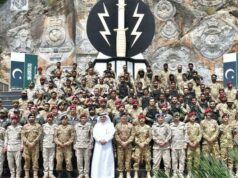Conflict at Nathu La
Written by
Major General V K Singh of Corps of Signals

In January 1964, Sagat handed over command of 50 Para Brigade to Brigadier A.M.M. Nambiar, and proceeded to attend the fourth course, at the National Defence College, in Delhi.
After spending a year on the course, he was posted as Brigadier General Staff 11 Corps, in January 1965. He served in this appointment for just six months, and in July 1965, was promoted Major General, and posted as GOC 17 Mountain Division, replacing Major General Har Prasad.
The division was then in Sikkim, and soon after he took over, there was a crisis. In order to help Pakistan during the 1965 War, the Chinese served an ultimatum, and demanded that the Indians withdraw their posts at Nathu La and Jelep La.
According to the Corps HQ, the main defences of 17 Mountain Division were at Changgu, while Nathu La was only an observation post. In the adjoining sector, manned by 27 Mountain Division, Jelep La was also considered an observation post, with the main defences located at Lungthu.
In case of hostilities, the divisional commanders had been given the authority to vacate the posts, and fall back on the main defences. Accordingly, orders were issued by Corps HQ to both divisions to vacate Nathu La and Jelep La.
Sagat did not agree with the views of the Corps HQ. Nathu La and Jelep La were passes, on the watershed, which was the natural boundary. The MacMahon Line, which India claimed as the International Border, followed the water shed principle, and India and China had gone to war over this issue, three years earlier.
Vacating the passes on the watershed would give the Chinese the tactical advantage of observation and fire, into India, while denying the same to our own troops. Nathu La and Jelep La were also important because they were on the trade routes between India and Tibet, and provided the only means of ingress through the Chumbi Valley.
Young husband had used the same route during his expedition, sixty five years earlier, and handing it over to the enemy on a plate was not Sagat’s idea of sound military strategy.
Sagat also reasoned that the discretion to vacate the posts lay with the divisional commander, and he was not obliged to do so, based on instructions from Corps HQ.
As a result of orders issued by Corps HQ, 27 Mountain Division vacated Jelep La, which the Chinese promptly occupied.
However, Sagat refused to vacate Nathu La, and when the Chinese became belligerent, and opened fire, he also opened up with guns and mortars, though there was a restriction imposed by Corps on the use of artillery. Lieut-General (later General) G.G. Bewoor, the Corps Commander, was extremely annoyed, and tried to speak to Sagat, to ask him to explain his actions. But Sagat was not in his HQ, and was with the forward troops.
So it was his GSO 1, Lieut Colonel Lakhpat Singh, who bore the brunt of the Corps Commander’s wrath.
The Chinese had installed loudspeakers at Nathu La, and warned the Indians that they would suffer as they did in 1962, if they did not withdraw.
However, Sagat had carried out a detailed appreciation of the situation, and reached the conclusion that the Chinese were bluffing. They made threatening postures, such as advancing in large numbers, but on reaching the border, always stopped, turned about and withdrew.
They also did not use any artillery, for covering fire, which they would have certainly done if they were serious about capturing any Indian positions. Our own defences at Nathu La were strong. Sagat had put artillery observation posts on adjoining high features called Camel’s Back and Sebu La, which overlooked into the Yatung valley for several kilometres, and could bring down accurate fire on the enemy, an advantage that the Chinese did not have.
It would be a tactical blunder to vacate Nathu La, and gift it to the Chinese. Ultimately, Sagat’s fortitude saved the day for India, and his stand was vindicated, two years later, when there was a show down at Nathu La. Today, the strategic pass of Nathu La is still held by Indian troops, while Jelep La is in Chinese hands.
During the crisis, the Chinese had occupied Jelep La, but had gained nothing in the sector under Sagat’s division. This was galling, and they continued their pressure on the Indians, and making threatening gestures. In December 1965, the Chinese fired on a patrol of 17 Assam Rifles, in North Sikkim, at a height of 16,000 feet, killing two men.
The patrol was in Indian territory, but the Chinese claimed that it had crossed over to their side. They made regular broadcasts from loudspeakers at Nathu La, pointing out to Indian troops the pathetic conditions in which they lived, their low salaries and lack of amenities, comparing these to that of officers.
It was a form of psychological warfare in which the Chinese were adept, and had to be countered. Sagat had similar loud speakers installed on our own side, and tape recorded messages, in Chinese language, were broadcast every day. However, he was not satisfied with this, and kept looking for a chance to avenge the death of the Indian soldiers who had fallen to Chinese bullets.
Throughout 1966, and early 1967, Chinese propaganda, intimidation and attempted incursions into Indian territory continued. The border was not marked, and there were several vantage points on the crest line which both sides thought belonged to them. Patrols which walked along the border often clashed, resulting in tension, and sometimes even casualties.
In 1967, Sagat discussed the problem with the Corps Commander, Lieut General J.S. Aurora. He suggested that the border at Nathu La should be clearly marked, to prevent such incidents, and offered to walk along the crest line, to test the Chinese resolve. If they did not object, the line along which he walked could be taken to be acceptable to them.
This was agreed to, and Sagat, accompanied by an escort, began walking along the crest. The Chinese commander also walked alongside, accompanied by a photographer, who kept taking pictures.
However, there was no confrontation, and the ‘walk’ ended peacefully.
Sagat then obtained the concurrence of the Corps Commander to mark the crest line, along which he had walked.
He ordered a double wire fence to be erected, from Nathu La towards the North and South Shoulders. However, as soon as work began on the fence, on 20 August 1967, the Chinese became agitated, and asked the Indians to stop. One strand of wire was laid that day, and two more were added over the next two days.
On 6 September, a patrol of 2 Grenadiers, the battalion which was holding defences at Nathula, was going towards the South Shoulder, when it was surrounded by about seventy Chinese, and threatened.
The next day, the Chinese physically tried to interfere with the construction of the fence, and there was a scuffle. However, work continued on the next two days, and was almost completed on the 10th.
Since the Chinese appeared determined to prevent completion of the fence, it was decided to start early on 11th, and finish the job before first light. All available manpower, including a platoon of Engineers and another of Pioneers, was deployed for the task.
A company of 18 Rajput was also brought in, to reinforce the position, and protect the men who were to construct the fence. As soon as work commenced, the Chinese came upto the fence, and tried to stop the work.
There was a heated discussion between the Chinese commander, who was accompanied by the political commissar, and Lieut Colonel Rai Singh, CO 2 Grenadiers. Sagat had foreseen this eventuality, and told Lieut Colonel Rai Singh not to expose himself, and remain in his bunker, where the Brigade Commander, Brigadier M.M.S. Bakshi, was also present. But this was not heeded, and the CO, with an escort, came out in the open, to stand face to face with the Chinese officers. As the arguments became more heated, tempers rose, but both sides stood their ground.
Suddenly, the Chinese opened fire, causing several casualties among the troops working on the wire fence. Lieut Colonel Rai Singh was hit by a Chinese bullet, and fell down.
Seeing their CO fall, the Grenadiers became mad with rage. In a fit of fury, they came out of their trenches, and attacked the Chinese post, led by Captain P.S. Dagar.
The company of 18 Rajput, under Major Harbhajan Singh, and the Engineers working on the fence had been caught in the open, and suffered a few casualties from the Chinese firing.
QARealising that the only way to neutralise the Chinese fire was a physical assault, Harbhajan shouted to his men, and led them in a charge on the Chinese position.
Several of the Indian troops were mowed down, by Chinese machine guns, but those who reached the Chinese bunkers used their bayonets, and accounted for many of the enemy.
Both Harbhajan and Dagar lost their lives in the action, which developed into a full scale battle, lasting three days. Sagat had asked for some medium guns, and these were moved up to Kyangnosa La, at a height of over 10,000 ft.
The artillery observation posts, which Sagat had sited earlier, proved their worth in bringing down effective fire on the Chinese. Because of lack of observation, and the steep incline West of Nathu La, most Chinese shells fell behind the forward defences, and did not harm the Indians.
At one stage, soon after their CO was wounded, there was a loss of morale in 2 Grenadiers, and some troops occupying the South Shoulder started upsticking. Sagat borrowed a sten from another officer, and with the help of the Subedar Major, pushed the men back into the trenches.
The Indian casualties in the action were just over two hundred – 65 dead and 145 wounded. The Chinese are estimated to have suffered about three hundred casualties. Though the action taken by Sagat, in marking the border with a wire fence, had the approval of higher authorities, the large number of casualties suffered by both sides created a furore.
Of course, the casualties to Indian troops would not have occurred if they had remained in their defences, and not exposed themselves by coming out of their trenches and rushing at the Chinese post.
This happened on the spur of the moment, because seeing their CO fall, the troops lost their cool, and rushed forward under the orders of a young officer, who lost his life in the action. The Corps Commander, Lieut General J.S. Aurora, visited Nathu La, to assess the situation. Sagat was advised to prevent further escalation of hostilities, and avoid casualties to Indian troops.
The Chinese had already announced that it was the Indians who started the conflict, and the large number of Indian bodies, and wounded Indian soldiers, in their possession, seemed to support their claim. However, Sagat was not perturbed. For the last two years, the Chinese had been instigating him, and had killed several Indian soldiers.
The specter of Chinese attack, of 1962, still haunted the military and political leadership in India and had prevented them from taking effective action against them. This was the first time the Chinese got a bloody nose, and the myth of their invincibility was broken.



